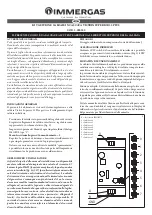
16
Instructions on commissioning, maintenance, and troubleshooting for auroSTOR 0020111119_02
8)
Exposure prevention and personal protective equip-
ment:
8a) Personal protective equipment:
Breathing protection: Breathing protection
if vapours/aerosols are released.
Hand protection: chemical-resistant protective gloves
(EN 374).
Recommended: Nitrile rubber (NBR), protection class
6.
Owing to the large variety of types, observe the
manufacturers' operating instructions.
Eye protection: Safety glasses with lateral protection
(framed glasses) (EN 166)
8b) General protection and hygiene measures:
The usual precautions for working with chemicals
must be observed.
9)
Physical and chemical properties:
Form:
Liquid.
Colour: Fluorescent red.
Smell:
Product-specific.
Freezing point: Approx. -25 ºC (ASTM D 1177)
Solidification point: Approx. -31 ºC (DIN 51583)
Boiling point: >100 ºC (ASTM D 1120)
Flashpoint:
N/A
Lower explosion limit: 2.6 vol% (propylene glycol)
Upper explosion limit: 12.6 vol% (propylene glycol)
Ignition temperature: N/A
Vapour pressure (20° C): 20 mbar
Density (20 ºC): Approx. 1,030 g/cm
3
(DIN 51757)
Solubility in water: Completely soluble
Solubility in other solvents: Soluble in polar
solvents
pH value (20 ºC): 9.0 - 10.5 (ASTM D 1287)
Viscosity (kinematic at 20 ºC): Approx. 5.0 mm
2
/s (DIN
51562)
10) Stability and reactivity:
10a) Substances to be avoided:
Strong oxidants
10b) Hazardous reactions:
No dangerous reactions if the storage and handling
regulations/notes are observed
10c) Hazardous decomposition products:
No dangerous decomposition products if the storage
and handling regulations/notes are observed.
11) Toxicology
information:
LD50/oral/rat: > 2000 mg/kg
Primary skin irritation (rabbits):
Non-irritant (OECD Directive 404).
Primary mucous membrane irritation (rabbits):
Non-irritant (OECD Directive 405).
11a) Additional
information:
The product has not been checked. The statements
are derived from the properties of the individual com-
ponents.
12) Ecology
information:
12a) Ecotoxicity:
Fish toxicity: Leuciscus idus/LC50 (96 h):
> 100 mg/l
Aquatic invertebrates: EC50 (48 h): > 100 mg/l
Aquatic plants: EC50 (72 h): > 100 mg/l
Micro-organisms/effect on activated sludge:
DEV-L2 > 1000 mg/l. If low concentrations are pro-
perly introduced into adapted biological waste water
treatment plants, no disturbances of the degradation
activity of activated sludge are to be expected.
12b) Assessment of aquatic toxicity:
The product has not been checked. The statements
are derived from the properties of the individual com-
ponents.
12c) Persistence and degradability:
Details regarding elimination:
OECD 301A test method (new version)
Analysis method: DOC acceptance
Degree of elimination: > 70 %
Assessment: easily biodegradable.
13) Information on disposal:
13a) Disposal:
When disposing of the fluid, you must observe all local
regulations, e.g. take the waste to a suitable dump or
incinerator. For quantities of less than
100 l, contact the local city cleaning department
or mobile environmental service.
13b) Contaminated
packaging:
Uncontaminated packaging can be reused. Packaging
that cannot be cleaned must be disposed of in the
same way as the material.
14) Information on transport:
Not dangerous goods in terms of the transport
regulations.
(ADR RID ADNR IMDG/GGV, see ICAO/IATA)
15) Legislation:
15a) European Union legislation (labelling)/national
regulations:
EU Directive 1999/45/EC
(Dangerous Preparations Directive):
No labelling obligation
15b) Other
legislation:
Water hazard class 1: Low hazard to water
(Germany, VwVwS of 17.05.1999).
4 Description of the components
















































